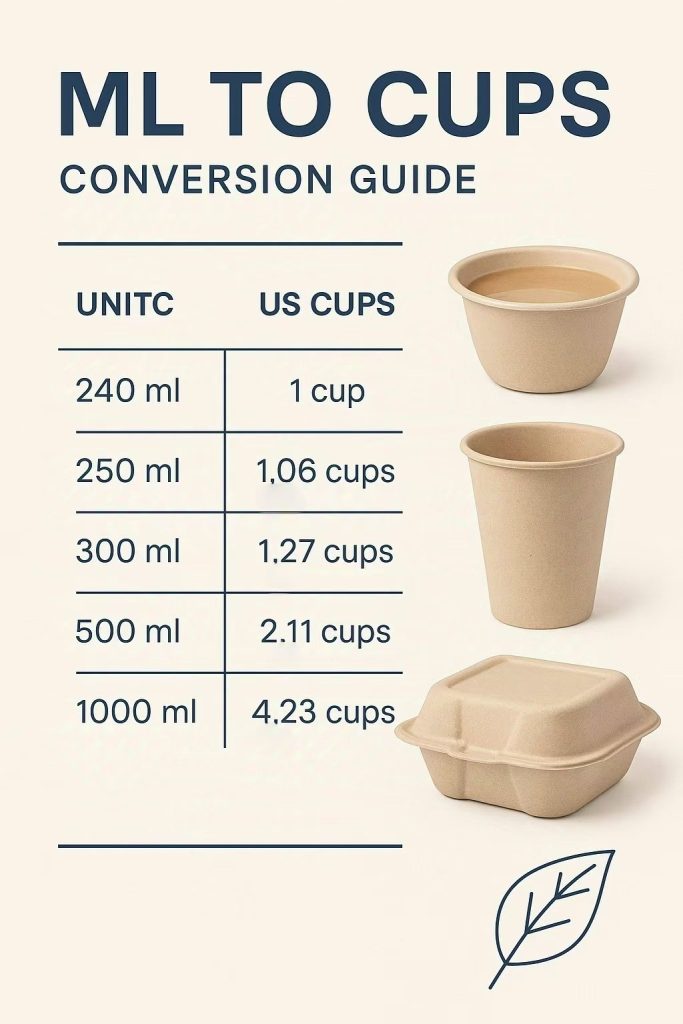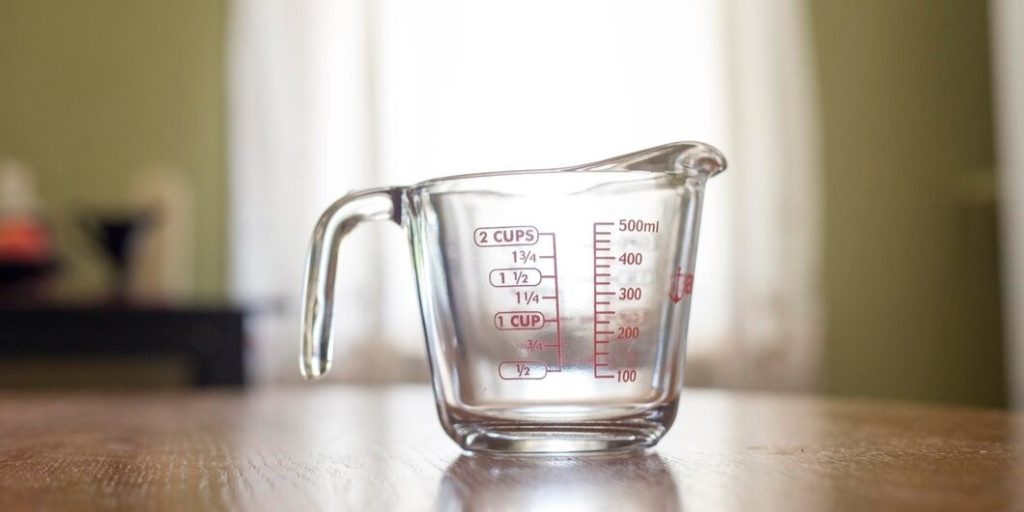Whether you’re following a recipe in your kitchen, portioning drinks for a café menu, or selecting the right container size for your foodservice business, understanding how milliliters convert to cups can make everyday decisions easier and more accurate.
In restaurants, meal kit services, and takeaway outlets, standard volumes like 250ml, 300ml, and 10oz aren’t just numbers—they guide how food is served, packaged, and consumed. This guide breaks down the most common volume conversions and shows how they relate to sustainable packaging formats, especially molded fiber products made from sugarcane bagasse.
Quick Conversion Table: Milliliters to Cups

It’s important to note that “cups” can vary depending on the measurement system(Source https://en.wikipedia.org/wiki/Cup_(unit):
- US cup = 236.6 ml
- UK (imperial) cup = 284 ml
- Metric cup (used in some recipes) = 250 ml
For packaging and foodservice applications, the US cup is typically used, especially when dealing with fluid ounces (fl oz) and standardized container sizes.
Then refer to the following conversion table for commonly used milliliter amounts:
| Milliliters (ml) | US Cups (approx.) |
|---|---|
| 240 ml | 1 cup |
| 250 ml | 1.06 cups |
| 300 ml | 1.27 cups |
| 500 ml | 2.11 cups |
| 1000 ml | 4.23 cups |
250ml in Cups: The Everyday Essential
If you’ve ever wondered how many cups 250ml equals, the answer is just over 1 cup—specifically, around 1.06 US cups. It’s one of the most commonly used sizes in both home cooking and commercial foodservice.
Typical uses include:
- Single-serving juice, milk, or smoothies
- Small side servings of soup or yogurt
- Portion-controlled pre-packed meals or desserts
At InNature Pack, we offer 250ml molded pulp bowls made from sugarcane bagasse—fully compostable, plastic-free, and perfect for side dishes or portion-sized desserts. These bowls can also be customized with printed logos or embossing to support your brand identity.
300ml in Cups: Compact and Versatile
300ml equals approximately 1.27 US cups. It’s a practical size used in both beverage and food applications and is often chosen for:
- Medium-sized coffee cups
- Single-serve soup or grain bowls
- Breakfast parfaits or fruit portions
Need a packaging solution for 300ml drinks or snacks? Our most relevant formats include single-use bagasse coffee cups and compact pulp bowls around the 300ml mark—designed for heat resistance and ideal for cafes or takeaway beverages. For clamshell-style containers, our closest volume options are typically 200ml or 450ml.
How Much Is 10 oz in ML?
To convert ounces to milliliters, the formula is simple:
1 US fluid ounce = 29.5735 ml.
So, 10 oz = 295.7 ml, which is why it’s often rounded to 300 ml in foodservice and packaging settings.
And if you’re sourcing 10oz packaging, we’ve got you covered—our pulp-based drink cups are labeled and sized specifically at 10oz, offering a perfect fit for medium coffee, juice, or iced drinks. These cups are 100% biodegradable, home-compostable, and printable for brand promotion.
250ml vs. 300ml vs. 500ml: Which One Should You Use?

Here’s a quick breakdown of what these common volumes look like—and how they work in practical packaging scenarios:
| Volume | Best Use Cases | Packaging Formats Available | Quick Tip |
|---|---|---|---|
| 250ml | Juice, sauces, desserts, small sides | Small cups, bowls, round lids | Great for portion control—ideal when you want to offer a lightweight, grab-and-go item. |
| 300ml | Coffee, yogurt, single-serve soups or smoothies | Drink cups, mini trays, single-serve bowls | A perfect mid-range size for cafes and takeout drinks—compact but filling. |
| 500ml | Full salads, noodles, rice meals, large beverages | Medium clamshells, rectangular trays | Choose this when your customers expect a full, satisfying meal or combo offering. |
When planning a new food or beverage product, aligning your portion size with these standards can streamline operations and reduce waste. It also helps with cost control and customer expectations.
Why Standard Volume Matters in Sustainable Packaging
Volume isn’t just about how much fits inside a container—it also affects how efficiently your packaging performs:
- Cost control: Avoid overfilling and reduce food waste
- Shelf and storage efficiency: Stackable, consistent sizes improve logistics
- Brand image: Thoughtful packaging sizing supports a more premium, intentional look
- Sustainability: Using the right size means fewer materials and smarter resource use
According to the U.S. Environmental Protection Agency (EPA), containers and packaging make up over 28% of municipal solid waste in the United States each year. Selecting the right-sized, compostable packaging not only avoids material overuse—it also helps reduce your landfill footprint
At InNature Pack, we manufacture eco-friendly molded pulp containers tailored to these practical volume points. Whether you’re running a juice bar, launching a meal kit, or looking for sustainable takeaway packaging, we have options that fit your size and sustainability goals.
Final Thoughts: Know Your Volumes, Pick the Right Packaging
Understanding basic volume conversions like ml to cups not only helps in food prep—it also gives you the confidence to choose the right packaging size for your food or beverage products.
Before selecting a container, ask yourself:
- Is this for a drink, snack, or full meal?
- Do I need portion control or maximum capacity?
- Will the product be used for hot or cold items?
Matching your product type with a standard volume like 250ml, 300ml, or 500ml helps avoid over-packaging, improves shelf efficiency, and reduces material waste. For more guidance on matching food types to packaging formats, check out our guide to choosing the right container size
Need help choosing the right volume or format? Contact InNature Pack for tailored guidance and free product samples—we’ll help you find the most practical, sustainable solution.
FAQ
1. How many cups is 250ml?
250ml is about 1.06 US cups—slightly more than one standard cup. It’s ideal for individual servings of juice, yogurt, or salad toppings.
2. How many cups is 300ml?
300ml equals roughly 1.27 US cups, which is why it’s commonly used in coffee cups or single-portion bowls for soup or noodles.
3. What is 10 oz in cups?
10 fluid ounces = 1.25 US cups. That’s why most medium takeaway drink sizes are designed around the 10oz/300ml range.
4. What kind of container fits 250ml of food?
A 250ml molded pulp bowl is ideal—compact, lightweight, and compostable. Great for sauces, desserts, and side dishes.
5. Is 300ml basically the same as 10oz?
Very close—10oz is 295.7ml, so 300ml is used interchangeably in most foodservice applications. It’s a standard choice for our pulp-based drinkware.

